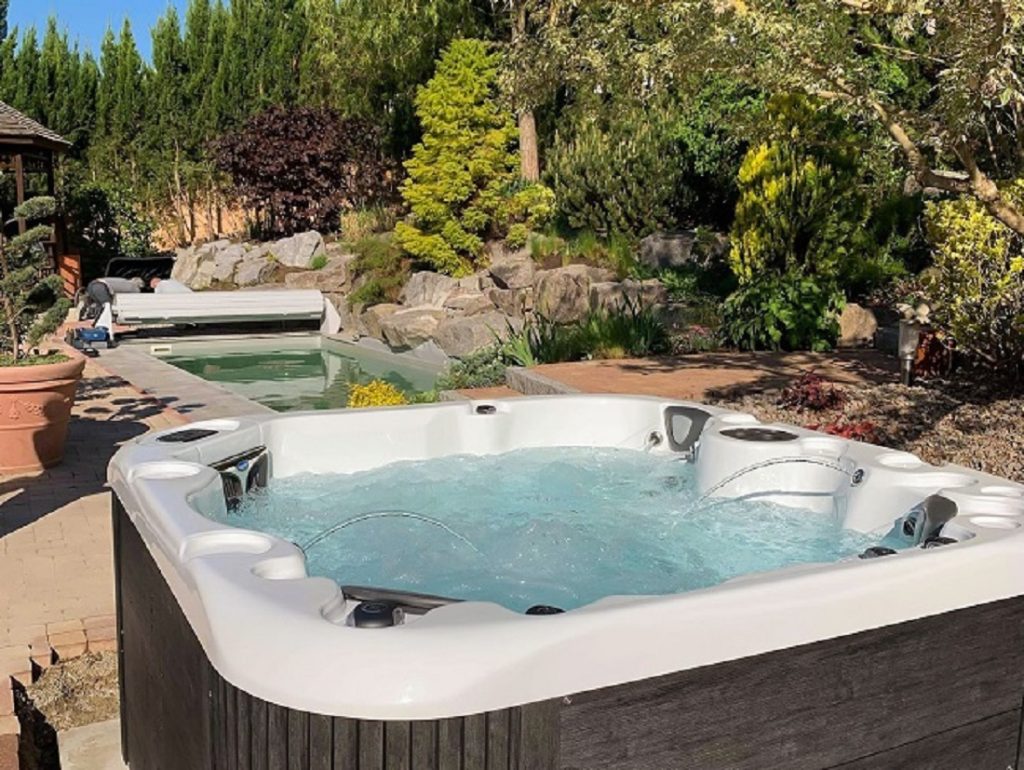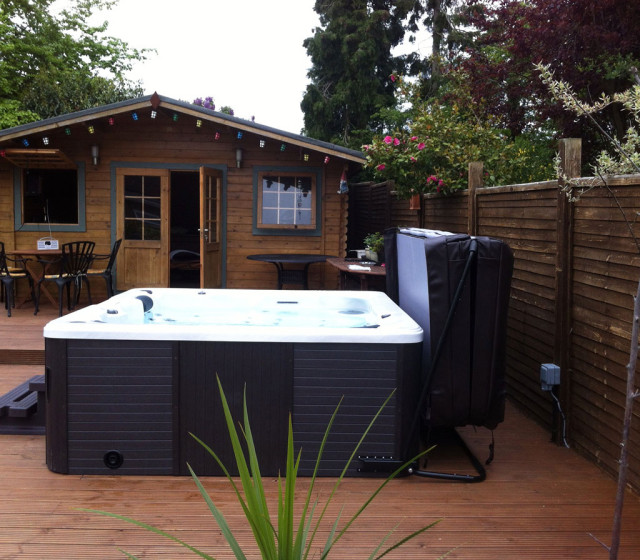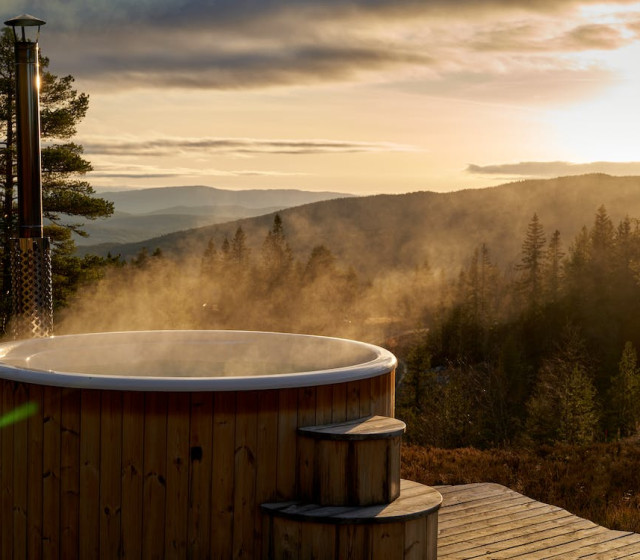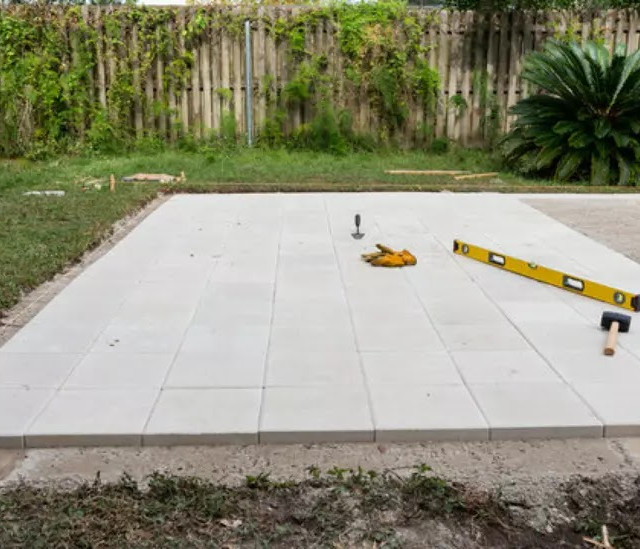Installing a hot tub can transform your space into a luxurious retreat that provides relaxation and comfort year-round. However, a successful hot tub installation requires careful planning and consideration of various factors.
In this detailed guide, we’ll answer the question of how to install a hot tub in your backyard or indoors, covering the basic steps from choosing the right location and determining your budget, to obtaining the necessary permits and understanding the cost of installation. In this article, you’ll find the information you need to make informed decisions and maximize your hot tub experience.
How to Plan Your Hot Tub Installation
Well, first things first, you need a good plan for your hot tub installation. This is an important step as you will be prepared and will make everything quicker. To get the most out of your investment, you need to carefully consider where to place the hot tub, how much it will cost, and what permits may be required. Now let’s get into the details.
The Right Location
Start by choosing the right place for your hot tub. These things are heavy enough that no one wants to move them several times, and no one wants to move them themselves. And to make it easier for you to decide, here are the main points you need to pay attention to.
- 👫 Convenience and accessibility. It should be convenient for you to approach the hot tub. For example, you can place it on your backyard deck or enclosed patio, and put steps next to the hot tub to make it easier for you to get into it;
- 🏡 Privacy. You may want to shield your hot tub from nosy neighbors. Privacy screen, fencing, or rooftop terrace is a good choice to create a comfortable area for your hot tub experience;
- View. A good view can add to your enjoyment while relaxing. Of course, it depends on where you are, but the view does play an important role and if you have a nearby mountain, forest, lake, or hill, then determine where it will be best seen from;
- 📏 Last but not least is the surface. It should be flat and sturdy so that your hot tub stays in one piece. The most common and reliable bases are a concrete patio and reinforced deck. They will last you a long time and can withstand a hot tub with water and people in it.
Setting a Budget
Budgeting is like making a shopping list before you go to the store. It will help you stay on track and avoid overspending. Calculate how much you are willing to invest in a hot tub, but don’t just think about the initial cost. Consider also the running costs such as maintenance, electricity, and water. The budget should cover the hot tub itself, the cost of installation, and additional features and accessories you want to add, such as lighting or jets.
Necessary Permits
Think of the installation permit as a necessary formality. In many areas, a permit is required before installing a hot tub, and failure to obtain one can lead to complications later.
The permitting process varies by location, so contact your local government or zoning department. They can help you complete the necessary paperwork and ensure that your hot tub complies with local regulations. Don’t worry, it’s usually not as complicated as it seems.
The list of states where installation permits are often required:
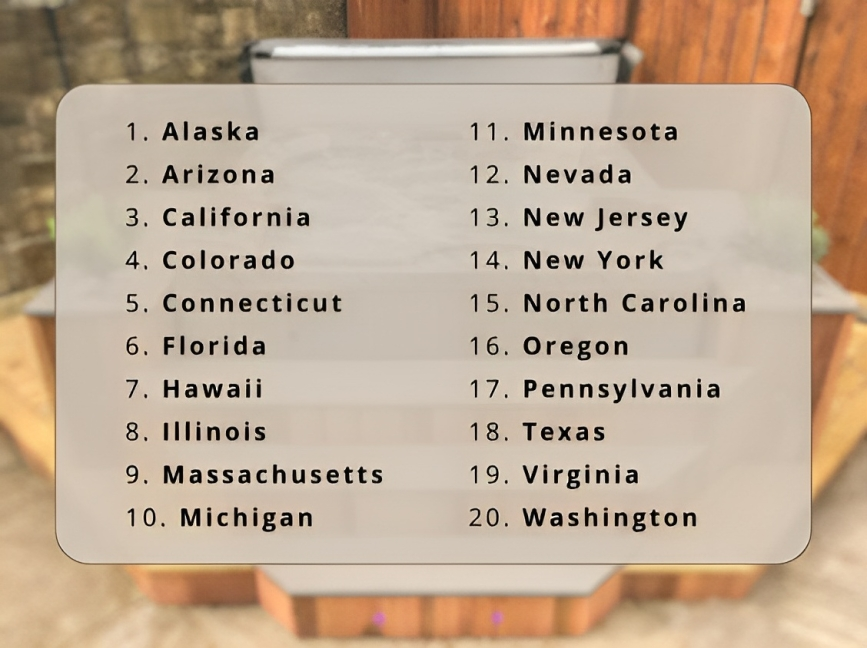
Installation Costs
You’ve got your permit, you’ve bought your hot tub, and you’ve chosen a place for it, so, what’s next? You will need to have it installed. Likewise, you need to prepare for this step and know what and how much you will need to install a hot tub.
Aside from the purchase price itself, hot tub installation includes delivery, electrical, and plumbing costs. These costs can vary depending on factors such as the distance of the installation site from power and water sources.
We have prepared a minimum cost estimate for do-it-yourselfers and those who want to call in a specialist. Also, keep in mind that despite the seemingly expensive cost, investing in the right installation will ensure that your hot tub will operate smoothly and safely for years to come.
| Costs | For DIY | For the work of a specialist |
| Delivery and transport | $200-$500 | $200-$500 |
| Site preparation | $500-$1,000 | $500-$1,000 |
| Electrical work | $100-$300 (if you have some electrical knowledge and can do part of the work yourself) | $500-$1,000 |
| Plumbing | $0-$100 (if no plumbing connections are needed) | $100-$300 |
| Permits and inspections | $100-$300 | $100-$300 |
| Total estimated cost | $900-$2,200 | $1,400-$3,100 |
Please note that these are rough estimates, and actual costs may vary significantly based on factors like location, specific installation requirements, the complexity of the project, and the professional’s rates. It’s crucial to obtain quotes from local professionals to get more accurate cost estimates for your specific situation.
How to Prepare the Space
With a properly prepared place, the installation of a hot tub will be many times easier. First, we are talking about the foundation. You need a solid and level surface. Whether the hot tub will be installed in the backyard or indoors, a proper foundation is a must.
The foundation or floor must be able to support the weight of the hot tub when it is filled with water and people. In addition, electrical and plumbing connections must be thought out, so be prepared to plan and make changes to existing systems if necessary. Proper preparation for installation will ensure the longevity of your desired purchase.
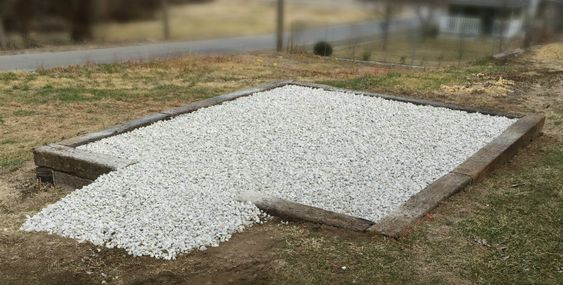
Solid Foundation
Just as a house needs a solid foundation, your hot tub needs a solid foundation. After all, it supports the hot tub, ensuring that it is level and secure. If you are installing your hot tub outdoors, you can use a concrete pad or sturdy decking as a foundation. If you want to explore this in more detail, you can refer to our previous article on how to install a hot tub base. Having a solid foundation minimizes the risk of your hot tub sagging or becoming uneven over time.
Electricity and Plumbing
Now let’s talk about the technical aspects. Your hot tub needs both electricity and plumbing to run smoothly. As for the electrical part, it is very important to have a dedicated (Ground Fault Circuit Interrupter) circuit. This is necessary for safety as it helps prevent electrical accidents.
In terms of plumbing, the hot tub will require water and drain connections. Some modifications may be required here if you are installing the hot tub in a new location. As with the electrical, plumbing work should be done by professionals who will ensure proper connections, prevent leaks, and ensure proper functioning. These technical aspects are the foundation of a hot tub, so getting them right from the start is the key to a carefree experience.
Outdoor Hot Tub Installation
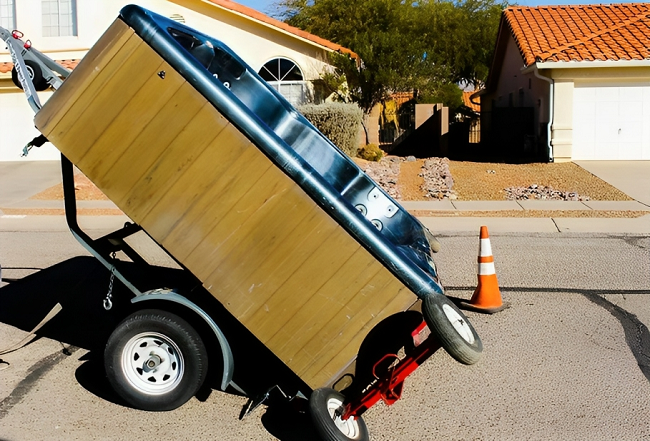
Well, installing an outdoor hot tub can be a wonderful addition to your home, providing a place to relax. You may be wondering how to install a hot tub outdoors. A successful outdoor hot tub installation involves three key components: delivery and placement of the hot tub, electrical connections, and water and drainage systems.
Before we get into these components in more detail, let’s take a look at a list of what you’ll need to install a hot tub and general stages.
| Tools and materials | General steps |
| – Hot tub and cover – Hot tub dolly – Foundation or platform (if necessary) – Electrical supply and circuit (if necessary) – Water supply and drainage connections – Shovel and leveling tools – Concrete blocks or pavers (if needed for leveling) – Plumbing fittings and connectors – Sealant or silicone (for sealing connections) – Garden hose or water source (to fill the hot tub) – Safety equipment (gloves, safety goggles) – A group of at least 2-3 people for help with placement | – With the assistance of a group of at least 2-3 people, carefully place the hot tub on the prepared and level foundation or platform. Ensure the hot tub is stable and secure. – Connect the plumbing components, including the inlet and outlet, for water circulation. Use appropriate plumbing fittings and connectors, and seal connections with sealant or silicone as needed to prevent leaks. – Follow the manufacturer’s guidelines and connect the hot tub to the dedicated circuit (if needed). – Ensure the connection is properly grounded and protected. A trench 20 inches (50 cm) deep is enough. Install safety measures like handrails, covers, and steps for easy and secure access to the hot tub. – Fill the hot tub with water using a garden hose or another water source. Fill it to the recommended water level, which is typically indicated by the manufacturer. – Test all components of the hot tub, including jets, heating, and filtration, to ensure they are functioning correctly. |
Delivery and Placement
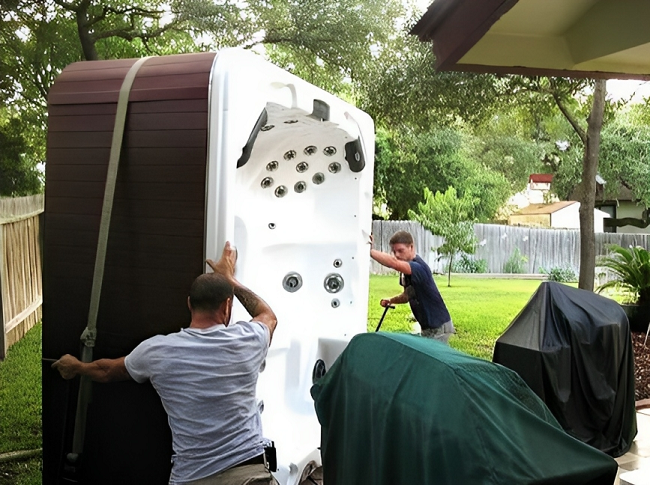
Delivery and placement seem simple, but there’s more to it than just bringing the hot tub in and leaving it in the yard. To ensure a safe and secure installation, the hot tub needs to be carefully placed on a sturdy and level surface. Access needs to be considered — how will the hot tub be transported to the installation site?
Here are some examples of what you may need to do:
- 🛠️ remove fences (for instance, when the access is limited);
- 🛠️ temporary demolition of parts of the house (if you need a certain type of foundation or support structure for your hot tub, for example);
- 🛠️ in some cases, even use a crane (in cases when the hot tub is large and heavy, as well as if you need to place it in hard-to-reach or elevated places).
Keep in mind that before the hot tub is installed, it is important to make sure that the surface is level and stable to avoid problems in the future.
Electrical Connection
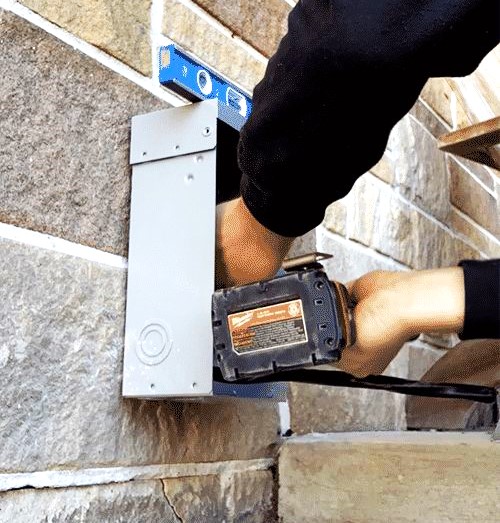
Now let’s talk about power. Here, we will look at 2 types of hot tubs: professionally wired and plug-and-play.
Professionally wired hot tub:
These hot tubs are not a DIY affair, as they involve electrical work that a professional electrician should do. They will set up a dedicated circuit with a Ground Fault Circuit Interrupter () to ensure safety. It quickly breaks an electrical circuit with leakage current to the ground. It will protect your equipment and reduce the risk of serious harm from an ongoing electric shock.
Plug-and-play hot tub:
They are designed to be more user-friendly and do not require professional electrical work. Plug-and-play hot tubs are typically equipped with a standard 120-volt plug that can be connected to a standard electrical outlet. This is a good choice for homeowners because such hot tubs are easier to set up, and they do not require installing a dedicated circuit.

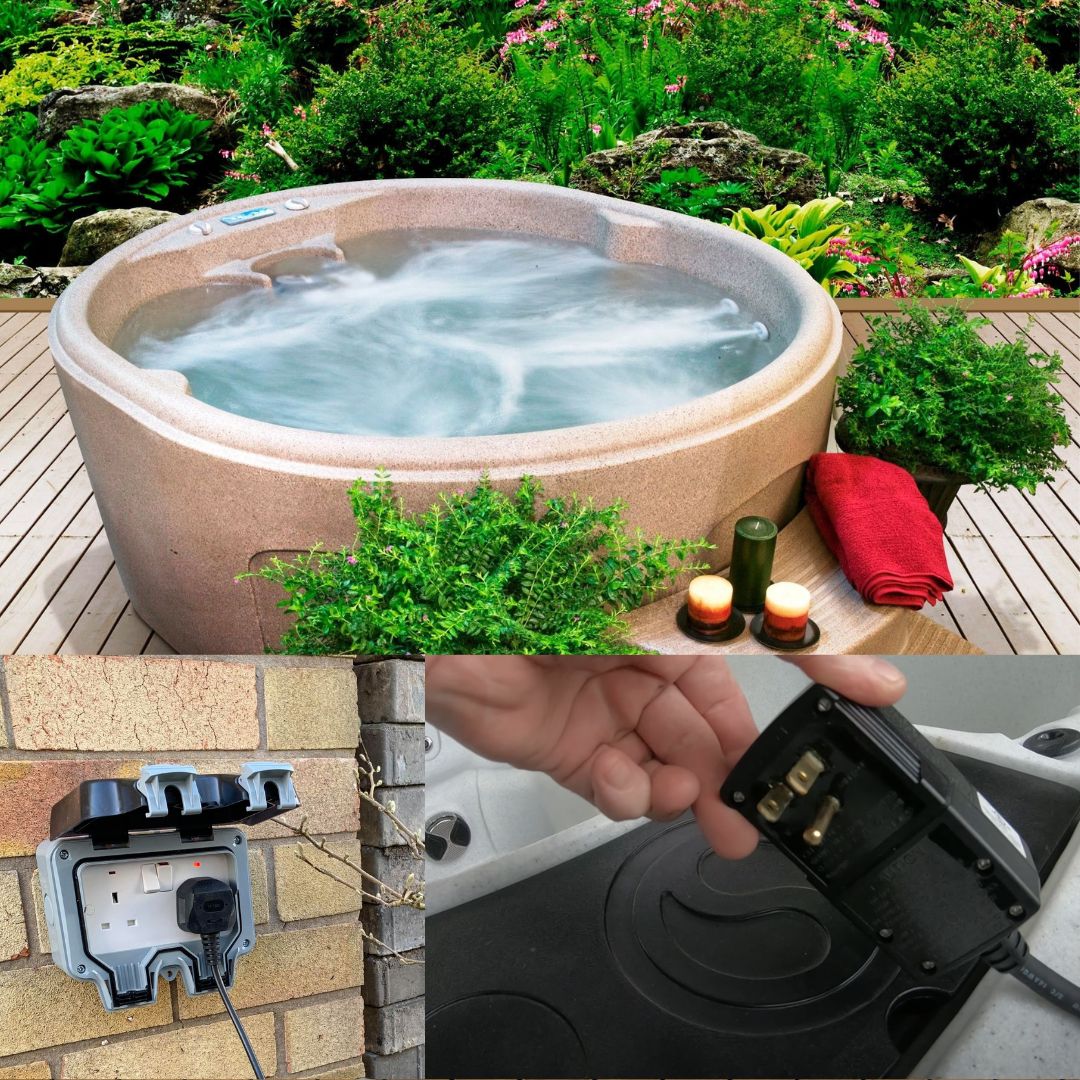
Water Supply and Drainage
A reliable water supply and drainage system is necessary for a hot tub to function properly. If you need a better understanding of plumbing, it is recommended that you hire a professional to install these connections (it depends on the size and type of the hot tub, however, it is mostly for professional wired ones). They will ensure that water flows into and drains from the hot tub without interruption, preventing leaks and water-related problems. Remember that proper water supply and drainage organization is the key to long-lasting use of your outdoor hot tub.
Indoor Hot Tub Installation
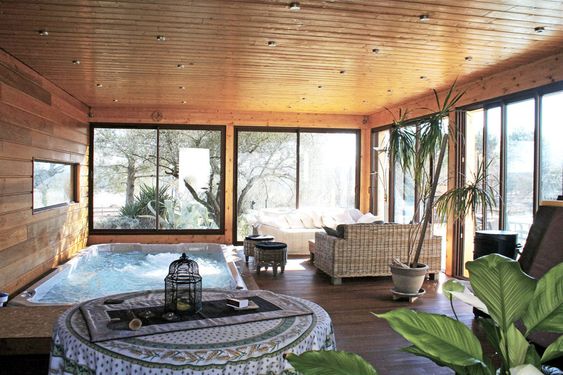
There are several things to consider for a successful and enjoyable installation of this type. We will guide you through the specific steps and factors to consider when installing an indoor hot tub.
Special Considerations
When installing hot tubs indoors, there are some specifics to consider.
- As with the outdoor option, you need to consider the installation location, but now in the house.
- You need to choose a room with good ventilation to regulate humidity and prevent problems such as mold.
- You also need to ensure that the structure is strong enough to support the weight of the hot tub, the water, and the people in it.
- In addition, you should consider the need for accessible electrical and plumbing connections.
- The interior space should be spacious enough for easy access and maintenance, while providing a peaceful atmosphere for relaxing in the hot tub.
There are some examples of good and bad locations for indoor hot tub installation:
| Suitable places | Unsuitable places |
| – Dedicated spa room – Basement – Enclosed patio – Room with adequate ventilation | – Bedroom or living room – Small or tight room – Carpeted area – Room with limited ventilation |

Why You Need a Hot Tub Enclosure
There are several reasons why the enclosure is an important component of a hot tub installation.
- It enhances the aesthetic appearance of the hot tub and serves a practical function.
- Enclosures help maintain proper temperature and humidity, providing a comfortable spa environment.
- They also provide privacy and soundproofing, making relaxing in the hot tub more enjoyable.
- In addition, enclosures protect from external influences, extending the life of the hot tub and reducing maintenance costs.
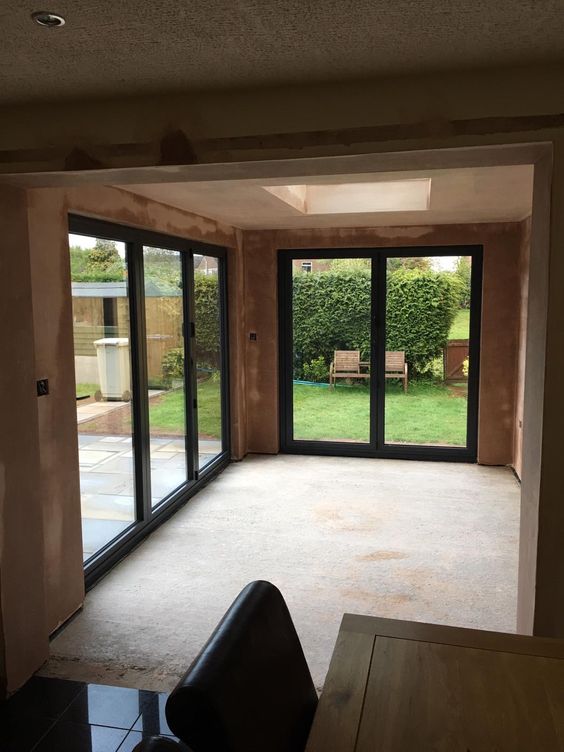
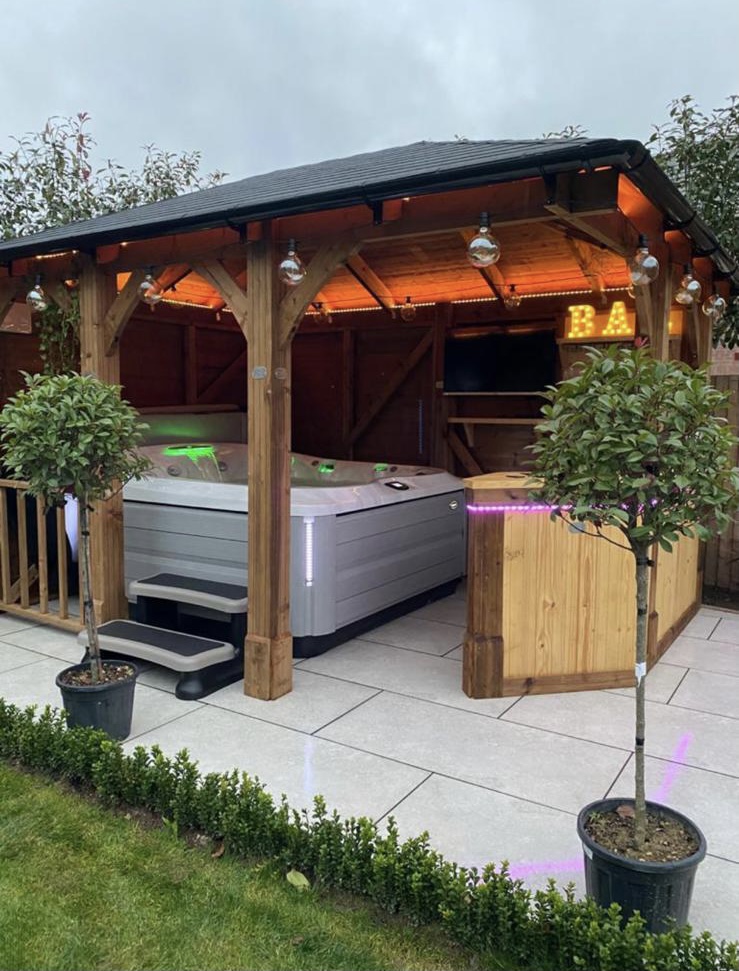
Safety and Maintenance
Safety and maintenance are of the utmost importance to hot tub owners. In this section, we will explain the precautions to take when using hot tubs and what maintenance work needs to be done to keep your hot tub in perfect condition.
Hot Tub Safety Precautions
Ensuring safety in and around the hot tub is a top priority. A clear set of precautions should always be kept in mind, and here are simple steps to follow.
👣 Firstly, you need to keep an eye on the temperature of the water. Typically, the water temperature in hot tubs ranges from 100 to 104°F (37-40°C). Staying in it for longer periods of time at higher temperatures can cause overheating, so the amount of time you stay in it should be reasonable.
👣 Also, never use a hot tub while under the influence of alcohol or drugs, as this impairs judgment and can be dangerous.
👣 Keep an eye on the water level so that it covers the jets but does not overflow.
👣 Those with long hair should be careful as hair can get in the nozzles.
👣 Finally, always supervise children in the hot tub and install a lock or safety cover when not in use.
These precautions will help create a safe environment for all hot tub users.
Routine Maintenance
Regular maintenance ensures that your hot tub runs smoothly and remains a clean and safe place to relax.
- One of the most important tasks is water care. Check and adjust the water’s pH level and sanitizer content to keep it free of harmful bacteria and algae. Hot tub chemicals will help with this task.
- Regular cleaning of your hot tub filter is critical to maintaining water quality. A dirty filter can reduce the effectiveness of hot tub water circulation and heating.
- Regularly clean the surfaces and waterline of the hot tub to prevent dirt and oils from accumulating.
- Also, inspect hot tub components such as the cover, jets, and seals monthly and seasonally for signs of wear or damage and repair them immediately.
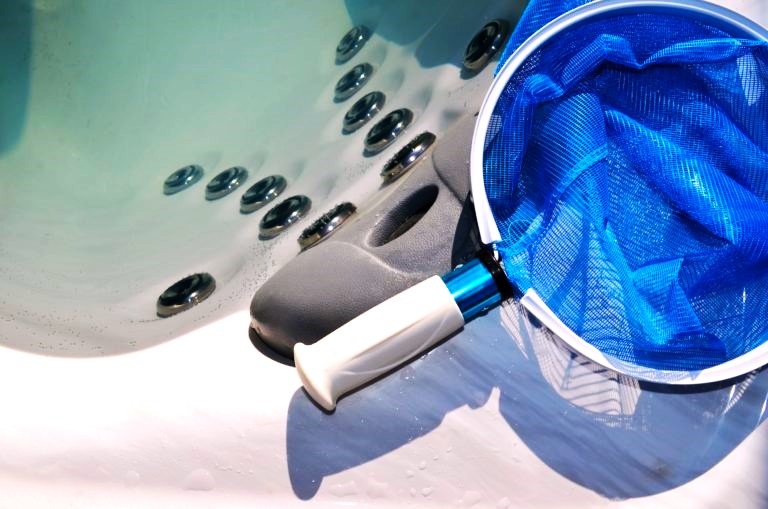
Expert Tips and Tricks on Hot Tub Installation
Here are useful and helpful tips from the hot tub experts that can elevate your hot tub experience and ensure a trouble-free installation.
- Choose a high-quality, well-insulated cover, as it can reduce heat loss, lower energy costs, and protect your hot tub from debris and weather.
- Inspect the hot tub seals and gaskets from time to time for wear and leaks. Replacing them promptly can prevent water damage and costly repairs.
- To calculate the total weight of a hot tub with water and people in it, you’ll need to consider the weight of the hot tub itself, the weight of the water, and the combined weight of the occupants. Here’s how you can calculate it:

- Check the manufacturer’s specifications or manual for the empty weight of your hot tub. This information is often provided in pounds (lbs) or kilograms (kg).
- A gallon of water weighs approximately 8.34 pounds (3.78 kg). You’ll need to know the water capacity of your hot tub, which is usually provided in gallons. Multiply the number of gallons by 8.34 to find the weight of the water.
- You’ll need to estimate the combined weight of the people in the hot tub.
For example, if your empty hot tub weighs 600 pounds, it can hold 400 gallons of water. You have two people in it, each weighing 150 pounds, the calculation would be as follows:
🖋 Weight of empty hot tub: 600 lbs
🖋 Weight of water: 400 gallons x 8.34 lbs/gallon = 3,336 lbs
🖋 Estimated weight of occupants: 2 people x 150 lbs each = 300 lbs
🖋 Total weight with water and people: 600 lbs + 3,336 lbs + 300 lbs = 4,236 lbs
4. Check with the delivery service whether the unloading of the hot tub is included in the curbside delivery. It may happen that they will deliver it to you, but you will have to unload it yourself. Therefore, be sure to ask about this issue.
5. When choosing a location for the hot tub, make sure there will be no trees above it. It will be a “lot of fun” to clean up leaves and other dirt that will fall from them.
Summary
In general, hot tub installation involves a number of critical steps such as site planning, costs, and obtaining permits. You will also need to prepare the foundation, electrical, and plumbing connections, which is very important for safe and reliable operation. Outdoor installation requires attention to delivery and placement, and drainage systems. On the other hand, indoor installation requires attention to specific considerations such as ventilation, structural support, and accessibility.
Safety and maintenance are paramount to the long-term use of a hot tub. Following safety precautions and regular maintenance such as water care and filter cleaning help maintain a safe and clean environment. In addition, tips from professionals, such as choosing a quality cover and checking seals, provide valuable information from experts.
Our article is suitable for both those who want to do everything themselves and those who will engage the help of professionals. Get the most out of your investment and create a relaxing space in your backyard or indoors.
FAQ
💰 How Much Does it Cost to Install a Hot Tub Indoor?
The cost of installing a hot tub indoors can vary, but on average, it can range from $5,000 to $10,000 or more. The price depends on factors like the hot tub’s size, features, and specific installation requirements.
🏡 How Much Does it Cost to Install a Hot Tub in the Backyard?
A basic outdoor installation may start at around $1,000 to $2,000 for site preparation, electrical work, and delivery, in addition to the cost of the hot tub itself. More complex installations can cost more, potentially ranging from $4,000 to $9,000 or higher.
🔧 How Hard Is It to Install a Hot Tub?
Installing a hot tub can be moderately challenging, depending on your DIY skills and the complexity of the installation. Basic outdoor installations may be manageable for DIY enthusiasts, but more complex setups, especially indoor installations, often require professional expertise.
⏳ How Long Does it Take to Install a Hot Tub?
The time it takes to install a hot tub varies based on factors such as the site’s preparation, electrical and plumbing connections, and any potential delays. Basic installations can take 2-4 days, while more complex projects, may require 1-2 weeks or more to complete. It’s important to plan for potential delays and ensure proper installation.
🔑 What are the Key Steps to Properly Install a Hot Tub?
The key steps include selecting the right location, ensuring a solid foundation, setting up electrical and plumbing connections, and preparing the space for your hot tub. This involves site preparation, delivery, and placement of the hot tub, and following local regulations and safety precautions.
⚡ What Electrical and Plumbing Work is Required to Install a Hot Tub?
Electrical work for a hot tub typically involves setting up a dedicated circuit with a Ground Fault Circuit Interrupter (GFCI) for safety. Plumbing work includes connecting the water supply and drainage lines to the hot tub.


